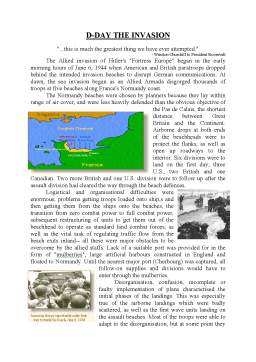Extras din referat
...this is much the greatest thing we have ever attempted."
- Winston Churchill to President Roosevelt
The Allied invasion of Hitler's "Fortress Europe" began in the early morning hours of June 6, 1944 when American and British paratroops dropped behind the intended invasion beaches to disrupt German communications. At dawn, the sea invasion began as an Allied Armada disgorged thousands of troops at five beaches along France's Normandy coast.
The Normandy beaches were chosen by planners because they lay within range of air cover, and were less heavily defended than the obvious objective of the Pas de Calais, the shortest distance between Great Britain and the Continent. Airborne drops at both ends of the beachheads were to protect the flanks, as well as open up roadways to the interior. Six divisions were to land on the first day; three U.S., two British and one Canadian. Two more British and one U.S. division were to follow up after the assault division had cleared the way through the beach defences.
Logistical and organisational difficulties were enormous; problems getting troops loaded onto ship,s and then getting them from the ships onto the beaches, the transition from zero combat power to full combat power, subsequent restructuring of units to get them out of the beachhead to operate as standard land combat forces, as well as the vital task of regulating traffic flow from the beach exits inland-- all these were major obstacles to be overcome by the allied staffs. Lack of a suitable port was provided for in the form of "mulberries", large artificial harbours constructed in England and floated to Normandy. Until the nearest major port (Cherbourg) was captured, all follow-on supplies and divisions would have to enter through the mulberries.
Disorganisation, confusion, incomplete or faulty implementation of plans characterised the initial phases of the landings. This was especially true of the airborne landings which were badly scattered, as well as the first wave units landing on the assault beaches. Most of the troops were able to adapt to the disorganisation, but at some point they would have to stop and reorganise to continue effective operations.
The physical geography of the beaches was important and a large part determined the type of troops that would be assigned to each objective. An example would be the cliffs at Pointe du Hoc. The 2nd and 5th (U.S.) Ranger Battalions trained for months to take this objective, and were able to achieve their goals in spite of the almost total collapse of their operations plan.
UTAH BEACH
UTAH BEACH was added to the initial invasion plan almost as an afterthought. The allies needed a major port as soon as possible, and UTAH BEACH would put VII (U.S.) Corps within 60 kilometres of Cherbourg at the outset. The major obstacles in this sector were not so much the beach defences, but the flooded and rough terrain that blocked the way north.
OMAHA BEACH
OMAHA BEACH linked the U.S. and British beaches. It was a critical link between the Contentin peninsula and the flat plain in front of Caen. Omaha was also the most restricted and heavily defended beach, and for this reason at least one veteran U.S. Division (lst) was tasked to land there. The terrain was difficult. Omaha beach was unlike any of the other assault beaches in Normandy. Its crescent curve and unusual assortment of bluffs, cliffs and draws were immediately recognisable from the sea. It was the most defensible beach chosen for D-Day; in fact, many planners did not believe it a likely place for a major landing. The high ground commanded all approaches to the beach from the sea and tidal flats. Moreover, any advance made by U.S. troops from the beach would be limited to narrow passages between the bluffs. Advances directly up the steep bluffs were difficult in the extreme. German strongpoints were arranged to command all the approaches and pillboxes were sited in the draws to fire east and west, thereby enfilading troops while remaining concealed from bombarding warships. These pillboxes had to be taken out by direct assault. Compounding this problem was the allied intelligence failure to identify a nearly full-strength infantry division, the 352nd, directly behind the beach. It was believed to be no further forward than St. Lo and Caumont, 20 miles inland.
V (U.S.) Corps was assigned to this sector. The objective was to obtain a lodgement area between Port-en-Bessin and the Vire River and ultimately push forward to St. Lo and Caumont in order to cut German communications (St. Lo was a major road junction). Allocated to the task were 1st and 29th (U.S.) Divisions, supported by the 5th Ranger Battalion and 5th Engineer Special Brigade.
Preview document
Conținut arhivă zip
- D-Day The Invasion.doc




















